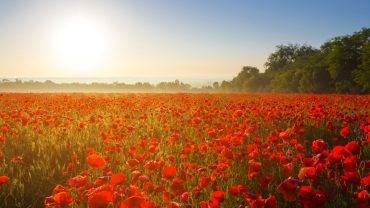Whether it’s sparkling on celebratory tables or swirled thoughtfully in a tasting room, wine has become a familiar friend to British aficionados. But its journey to this point has been anything but straightforward.
Blending conquest, climate shifts, and centuries of changing taste, Britain’s wine history is full-bodied and far from predictable. Thirsty for the details? Let’s pour over the past and find out all about the history of British wine.
Roman Roots

The Romans brought wine to Britain in amphorae (Credit: George Pachantouris via Getty Images)
So, when did wine first hit British shores? While this is usually traced back to the Romans, it probably predates them, having been imported by tribal chieftains keen on luxury goods from the continent. However, it was almost certainly the Romans who systematically introduced organised wine-making, or “viticulture,” as well as popularising wine-drinking.
Following their invasion in 43 AD, the Romans initially imported wine from Gaul (modern-day France) and the Mediterranean. Excavations in London, Bath, and Colchester reveal countless shards of amphorae filled with robust reds and fragrant whites, highlighting wine’s popularity among both soldiers and Britain’s elite.
Yet, it seems the Romans weren’t content with imports alone. They established vineyards as far north as Lincolnshire, capitalising on Britain’s milder climate during this period. Historical evidence suggests the wine produced was of varying quality, but its presence marked an early chapter in British winemaking.
Dark Age Decline

Vineyards were neglected during the Dark Ages (Credit: Image by Jason Bouwman via Getty Images)
With the fall of Rome in the 5th century and the ensuing instability, both wine imports and production dwindled significantly. Many vineyards were destroyed or neglected. This decline was further exacerbated by the waning influence of Christianity, which had bolstered the significance of wine through its ceremonial use.
While it probably didn’t disappear entirely, wine’s status in the centuries that followed was tenuous at best. There was some recovery with the reestablishment of Christianity and later evidence of vineyards from the 8th century onwards, but these accounts are spotty and disparate.
The Normans Revitalise English Viticulture

The Domesday Book listed dozens of vineyards in England (Credit: duncan1890 via Getty Images)
The Norman conquest in 1066 marked a resurgence in English viticulture, especially through monasteries, where wine was vital for religious rites. This was further bolstered by the fact that England was experiencing a relatively warm climatic period – especially in the south – providing favourable conditions for grape cultivation. In fact, the Domesday Book of 1086 recorded over 40 vineyards, many of them attached to ecclesiastical estates. Alongside increased production, the Norman period also saw wine gain status as a symbol of refinement.
A Major Medieval Import

Henry and Eleanor brought French wine to England (Credit: imageBROKER/Sunny Celeste via Getty Images)
Even after the Normans, Britain’s love of wine continued to grow. The same could not however be said of British viticulture. As the Middle Ages progressed, England’s vineyards faced a dual threat: worsening weather and rising foreign competition. From the 12th century onwards, the country’s climate turned cooler and wetter, curbing the success of domestic grape-growing. But the most significant blow came in 1152, when Eleanor of Aquitaine’s marriage to Henry II brought the duchy of Gascony – and its prolific vineyards – under English control.
This new political union dramatically shifted England’s wine priorities. Bordeaux’s claret, abundant and of higher quality than local fare, became the wine of choice for the English elite. Imports surged, and domestic vineyards struggled to keep pace. Wine, though increasingly prominent at court and in church ceremonies, was now more often French than English. Only monastic and aristocratic estates kept up limited local production, their efforts overshadowed by the ease and appeal of continental supply.
By the time the Reformation arrived in the 16th century, bringing with it the dissolution of the monasteries, the last institutional guardians of English viticulture were swept aside. Though the tradition never vanished entirely, it had long been relegated to the margins, surviving only in isolated pockets amid the growing dominance of imported wine. Yet this reliance on French imports would soon face a reckoning, not from climate or competition, but from the long shadow of war.
War and Wine

Samuel Pepys described wine as an everyday drink (Credit: ilbusca via Getty Images)
The Hundred Years’ War began in 1337. By the time it ended in 1453, England had lost control of all its French territories and most of its access to French wine. This, combined with English tariffs and penalties on French imports, allowed Spain and Portugal to step into the breach.
By the 17th century, an expanding middle class – merchants, professionals, civil servants – had begun to partake more regularly. Diaries like that of Samuel Pepys capture this shift, showing wine as part of daily civil life.
Georgians and Victorians: Importers and Innovators

Wine was an important part of Victorian parties! (Credit: PATSTOCK via Getty Images)
The 18th and 19th centuries marked a significant expansion in Britain’s wine culture, reflecting broader social changes and the evolving tastes of a nation on the move. In Georgian Britain, wine was integral to a culture of conspicuous drinking, particularly among the elite. Fortified wines like Port and Madeira were favoured, often consumed in substantial quantities during lavish gatherings. This period saw excessive alcohol consumption celebrated as a masculine virtue, with wine playing a central role.
The 19th century ushered in the Victorian era, marked by industrialisation and the rise of a prosperous middle class. Eager to emulate aristocratic customs, this “middling sort” embraced wine as a symbol of refinement. What’s more, legislative changes, notably the 1860 Treaty of Commerce championed by William Gladstone, reduced duties on imported wines, making them more accessible. This policy, coupled with the expansion of the British Empire, introduced consumers to a diverse array of wines from colonies including Australia and South Africa.
The Modern British Wine Renaissance

A thriving vineyard in Devon (Credit: Mypurgatoryyears via Getty Images)
The late 20th and early 21st centuries marked a dramatic shift in the British attitude towards wine. Driven partly by a changing climate, English wine production – particularly sparkling wines – saw a spectacular revival. Warmer summers and milder winters transformed the chalky slopes of southern England, making them surprisingly similar to Champagne’s famed terroir. Vineyards in Sussex, Hampshire, and Kent have gone on to produce award-winning sparkling wines. Moreover, British consumer tastes diversified significantly. Rosé, once considered unfashionable, became emblematic of modern, casual sophistication, frequently enjoyed by Britons across social occasions from summer garden parties to city-centre brunches.
The British Bottle: A Story of Resilience and Adaptation

Cheers! (Credit: habovka via Getty Images)
From the Romans planting vines along the sunny slopes of southern Britain to contemporary winemakers pushing vineyards into uncharted northern territories, the history of wine in Britain is a narrative of adaptability, innovation, and evolving tastes. And as climate, culture, and curiosity continue to evolve, it’s fair to assume that the story of wine in Britain is far from over.












